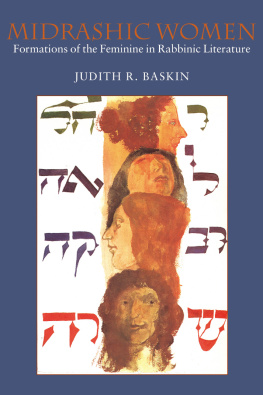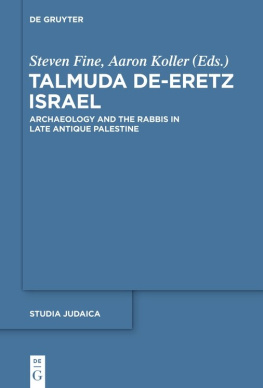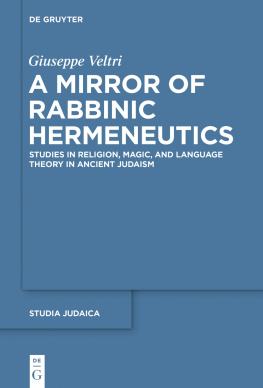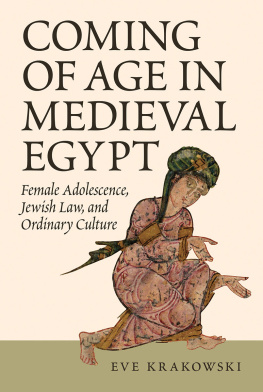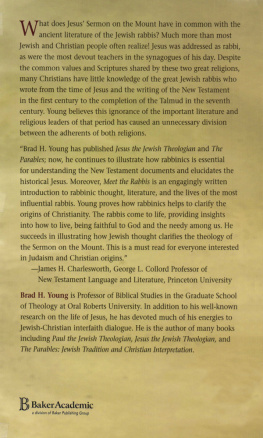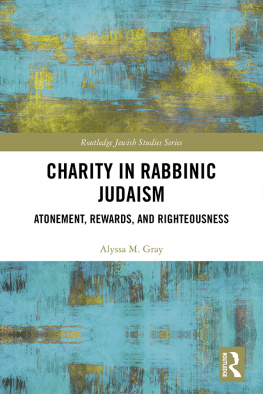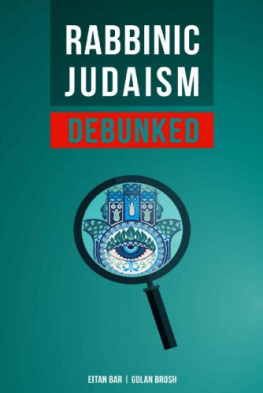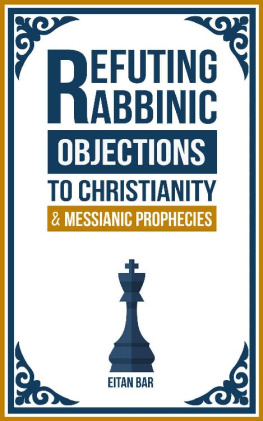NOTE ON TRANSLATIONS AND ABBREVIATIONS
All biblical quotations are from Tanakh: A New Translation of the Holy Scriptures According to the Traditional Hebrew Text (Philadelphia: The Jewish Publication Society of America, 1985), except in those instances where changes were necessitated by the midrashic context. Biblical quotations appear throughout the book in an alternative font so that they will stand out from the rest of the text. Non-English words appear in transliteration within biblical or rabbinic quotations when the Hebrew or Aramaic is central to the passages exegetical argument.
Translations from the Mishnah are based on those in The Mishnah: Translated from the Hebrew with Introduction and Brief Explanatory Notes by Herbert Danby (Oxford: Oxford University Press, 1933). Translations from the Babylonian Talmud are grounded in The Babylonian Talmud, ed. I. Epstein, 18 vols. (London: The Soncino Press, 1936). Translations from Midrash Rabbah are grounded in Midrash Rabbah, trans. H. Freedman, 9 vols. (London: The Soncino Press, 1938). Translations from Avot de-Rabbi Nathan A are informed by The Fathers According to Rabbi Nathan, translated from the Hebrew by Judah Goldin (New Haven: Yale University Press); those from Avot de-Rabbi Nathan B are informed by The Fathers According to Rabbi Nathan. A Translation and Commentary by Anthony J. Saldarini (Leiden: E. J. Brill, 1975). Translations from Pesiqta de-Rav Kahana are grounded in Pesikta de-Rab Kahana: R. Kahanas Compilation of Discourses for Sabbaths and Festal Days, translated from Hebrew and Aramaic by William G. Braude and Israel Kapstein (Philadelphia: Jewish Publication Society, 1975). Translation from Tanna Deve Eliyyahu are informed by Tanna Debe Eliyyahu, translated by William G. Braude and Israel Kapstein (Philadelphia: Jewish Publication Society, 1981). Translations from other rabbinic texts are my own unless otherwise indicated.
The following abbreviations are used for biblical books: Gen. (Genesis), Ex. (Exodus,), Lev. (Leviticus), Num. (Numbers), Deut. (Deuteronomy), Josh. (Joshua), Judg. (Judges), Sam. (Samuel), Kgs. (Kings), Isa. (Isaiah), Jer. (Jeremiah), Ezek. (Ezekiel), Zeph. (Zephaniah), Zech. (Zechariah), Mal. (Malachi), Ps. (Psalms), Prov. (Proverbs), Song (Song of Songs), Lam. (Lamentations), Ecc. (Ecclesiastes), and Chron. (Chronicles). The apocryphal book, The Wisdom of Ben Sira, is abbreviated as Ben Sira.
These abbreviations are used in citing rabbinic works: M. (the Mishnah), B. (the Babylonian Talmud), J. (the Talmud of the Land of Israel), and T. (Tosefta). Square brackets within quotations from rabbinic texts generally indicate words added in order to clarify the meaning of the passage.
ACKNOWLEDGMENTS
This book has been in progress for many years. I am grateful to my teacher, Judah Goldin, zl, in whose graduate seminars at Yale University I first undertook the study of midrash and who encouraged me to write about Rahab. I am glad to thank friends and colleagues who read parts of this volume, or listened to papers based on its contents, and offered helpful suggestions; these include Alan Avery-Peck, Jennifer Fleischner, Mayer Gruber, Paula Hyman, Tal Ilan, Ross Shepard Kraemer, Susan Niditch, Vanessa Ochs, Miriam Peskowitz, Laura Levitt, Maurie Sachs, Jonathan Seidel, Susan Shapiro, Cheryl Tallan, Judith Romney Wegner, and Walter Zenner. I would also like to thank Jacob Neusner, who has offered generous encouragement of my research and writing over the years. I owe a special debt to Berel Lang, who encouraged me to undertake this project, and I am grateful to Sylvia Barack Fishman and Shulamit Reinharz for welcoming my work into the Brandeis Series on Jewish Women, with the support of the Hadassah International Research Institute on Jewish Women. I offer special thanks to my editor Phyllis Deutsch for her patience.
My work in the Womens Caucus of the Association for Jewish Studies throughout the 1990s and my collaborations with other scholars investigating Jewish womens history and literature have been significant sources of inspiration to me. I would particularly like to acknowledge the support and friendship of Howard Adelman, Sarah Blacher Cohen, Judith Hauptman, Deborah Hertz, Sara Horowitz, Carole Kessner, Miri Kubovy, Rochelle Millen, Pamela Nadell, Frances Malino, Rene Levine Melammed, Riv-Ellen Prell, Ellen Schiff, Emily Taitz, Shelly Tenenbaum, Ellen Umansky, Dvora Weisberg, Chava Weissler, and Laura Wexler. I am grateful, as well, to the University at Albany, State University of New York, for a sabbatical leave in the Fall of 1999, which allowed me to complete important work on this book.
My uncle, the American sculptor and graphic artist Leonard Baskin, zl, was a man of immense learning and outsized talent and personality. He took great pleasure in rabbinic aggadah and was always interested in my work. I am delighted that his illustration, Four is the Number of the Matriarchs (A Passover Haggadah. The New Union Haggadah, ed. Herbert Bronstein [New York: Central Conference of American Rabbis, 1974]) is reproduced on the cover of this book. I would like to thank the Central Conference of American Rabbis for permission to reprint this stunning image here.
It is a great honor to be the first Director of the Harold Schnitzer Family Program at the University of Oregon. I am grateful to the Schnitzer family for their vision and for their generous support of the publication of this volume.
My son Sam and my daughter Shira are great sources of pride and happiness to me. I thank them for tolerating my preoccupation with this project over a long period of time. I am most blessed in my parents, Marjorie and Rabbi Bernard Baskin; they have always been models to me of committed engagement to life and learning. My husband Warren Ginsberg and I first met thirty years ago as fellow graduate students in the Medieval Studies doctoral program at Yale. It has been a great joy and privilege to share my life with Warren, a genuine scholar and a true mensch, and I dedicate this volume to him with all my love.

AFTERWORD
When the daughters of Zelophehad heard that the land of Israel was being apportioned among the males of the tribes but not the females, they consulted together as to how to make their claim. They said: The compassion of God is not like human compassion. Human rulers favor males over females but the One who spoke and brought the world into being is not like that. Rather, God shows mercy to every living thing, as Scripture says, Who gives food to all flesh / Whose steadfast love is eternal (Ps. 136: 24) and The Sovereign is good to all / Gods mercy is upon all Gods works (Ps. 145: 9).
(Sifre Numbers 133)
T he sages, who formed, compiled, and edited rabbinic literature over several centuries and across a large geographic area, were all men. Although the estimable body of writing the rabbis produced expresses diverse points of view on virtually every conceivable topic, it preserves very few female voices. Contemporary students of this tradition must begin with the knowledge that rabbinic literature is inherently oriented towards men, conveying a one-sided picture of Jewish life, religious ritual, and spirituality in late antiquity. Moreover, the apparent multivocality of rabbinic literature rests on a number of inalterable principles and beliefs. Among them is the conviction of womans secondary status as a created being who is other than man in her abilities and talents and of lower status in human society.
Female alterity begins with the corporeal. Women are defined by their bodies and by bodily functions. As objects of temptation and sources of pollution, they are experienced by men as both sexually attractive and physically repellant. Moreover, as passive vessels who do not generate new life, females are anomalous bystanders to the convenantal relationship between God and Israel. Yet women are acknowledged to be essential to men at the same time as they portend potential problems. In the rabbis ideal vision of the world, this dilemma is resolved by confining females to domestic enabling roles, facilitating the endeavors of their husbands and sons.
Next page
